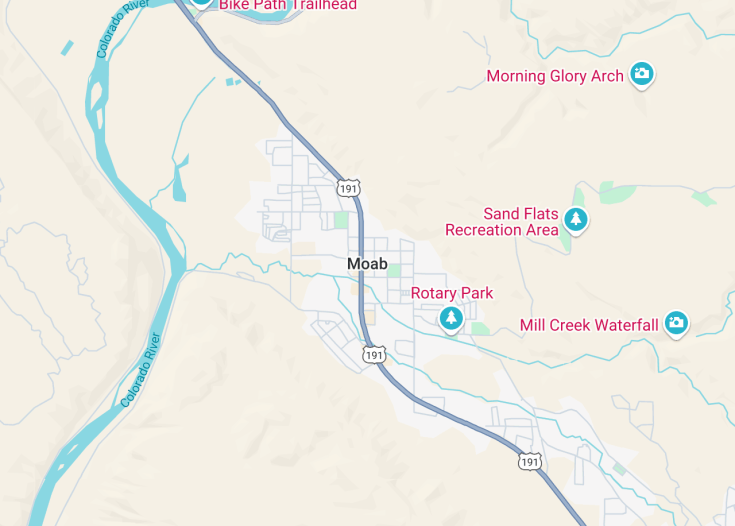Moab, Utah, is an unparalleled natural wonderland, renowned worldwide for its dramatic landscapes that seamlessly blend towering red rock formations, deep canyons, and sweeping plateaus. Gateway to the spectacular Arches and Canyonlands National Parks, Moab offers adventure and tranquility alike, attracting thrill-seekers, nature enthusiasts, and photographers in search of sublime desert beauty and myriad recreational activities, from hiking and biking to river rafting and rock climbing. Its unique geological features and the serene Colorado River provide a stunning backdrop for exploration and relaxation.
Before heading to Moab, check the seasonal weather conditions; spring and fall offer the most temperate climate for outdoor activities.
Consider booking accommodations well in advance, especially during peak visiting times in spring and fall, to secure your ideal lodging options.
Top things to do & see in Moab
Select the following sights and activities to discover best tickets and tours available in Moab.
Moab: The Heart of Red Rock Country
| Country | USA |
| Time in Moab | GMT-7 |
| Language spoken | English |
| Population | 5,366 (source: U.S. Census Bureau, 2020) |
| Currency | U.S. Dollar (USD $) |
| Airports |
|
Moab, Utah serves as a vibrant gateway to the vast, rugged beauty of the American Southwest. Known for its stunning red sandstone landscapes, Moab attracts adventurers and photographers alike. The town’s history is deeply intertwined with the Ute tribes and later settlers who mined and farmed the region. Today, Moab’s economy thrives on tourism, driven by its proximity to iconic natural attractions like Arches National Park and Canyonlands National Park.
Moab has well-defined seasons, with hot summers perfect for river rafting and mild winters that are ideal for hiking. Cultural events such as the Moab Music Festival and Jeep Safari Week highlight a community rich in outdoor enthusiasm and artistic flair. Accommodations range from rustic campgrounds to luxury spas, catering to all levels of comfort and adventure. Local cuisine captures the spirit of the West, with a focus on hearty, flavorful dishes that often feature local ingredients.
Where is Moab?
Moab is located in southeastern Utah, nestled between the Colorado River and the La Sal Mountains.
Distances:
| Route | Distance by car | Time by car |
|---|---|---|
| Salt Lake City to Moab | 236 mi | Approximately 3h 45min |
| Denver to Moab | 354 mi | Approximately 5h 30min |
| Las Vegas to Moab | 456 mi | Approximately 6h 50min |
What is Moab famous for?
Moab is famous for its stunning red rock landscapes, particularly the iconic arches and rugged terrain featured in Arches National Park. It’s a premier destination for mountain biking, off-road vehicle driving, and rock climbing.
History
Prehistoric Period – Before 10,000 BCE to 1300 CE
The area known as Moab, located in southeastern Utah, has a rich prehistoric presence, primarily marked by the Ancestral Puebloans, who settled here around 10,000 BCE. These early inhabitants were primarily hunter-gatherers, and later evolved complex farming societies, constructing cliff dwellings and sophisticated irrigation systems. Ruins and petroglyphs in Moab’s red rock landscapes are testament to their presence and sophisticated culture.
Exploration and Naming – 1855 to 1880
The first European-American missionaries and explorers arrived in the Moab area around 1855, with permanent settlements established by 1880. Moab gets its name from the Biblical land across from ancient Israel and was possibly named for its remote, somewhat isolated position in relation to the rest of Utah.
20th Century Development – 1900s to 1990s
In the early 20th century, Moab was primarily a small farming community. However, by the late 1950s, a uranium boom brought a period of rapid growth and economic change as the area became a mining hub during the Cold War period. This era defined Moab’s economic landscape until the uranium market declined in the 1980s.
Modern Era – 1990s to Present
With the decline of uranium mining, Moab shifted its focus to tourism, exploiting its unique landscape that is ideal for outdoor sports like mountain biking, hiking, and river rafting. This transformation into a recreational hub has marked the most recent chapter in Moab’s history, with the town emerging as a favorite destination for adventure enthusiasts worldwide.
Visit Moab
What to see and do in Moab, Utah (USA)
Moab, Utah, serves as a gateway to the vast red rock landscapes of Arches and Canyonlands National Parks. Visitors can explore over 2,000 natural stone arches at Arches National Park, including the iconic Delicate Arch. Canyonlands offers a deeper dive into wild, rugged canyons and mesas. Adventure enthusiasts can enjoy mountain biking on the Slickrock Trail, one of the most famous biking trails in the world. Besides, the Colorado River provides excellent opportunities for rafting and kayaking.
- Visit Arches National Park
- Explore Canyonlands National Park
- Mountain biking on the Slickrock Trail
- Rafting and kayaking on the Colorado River
Festivals and Events in Moab
Moab hosts numerous annual events attracting worldwide visitors. The Moab Music Festival, held in late summer and early fall, blends musical performances with the natural acoustics of red rock venues. Jeep Safari, occurring in spring, brings off-road enthusiasts to tackle the rugged terrain. Other events include the Moab Folk Festival and the Moab Trail Marathon.
Best time to visit Moab
The ideal times to visit Moab are during spring (April to May) and fall (September to October). These months offer comfortable temperatures, suitable for exploring the outdoors and participating in festivals, with fewer crowds than the peak summer season.
Is Moab worth visiting?
Moab is undoubtedly worth visiting for anyone that cherishes natural beauty and outdoor adventures. Its unique and spectacular red rock landscapes offer endless recreational activities, from hiking and biking to rafting. The access to two of America’s stunning national parks further makes it a compelling destination for both nature lovers and adventure seekers.










